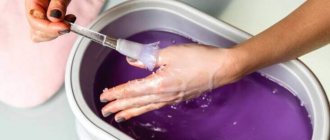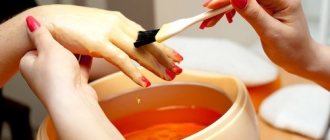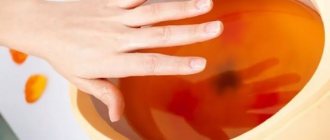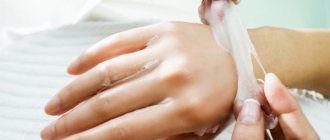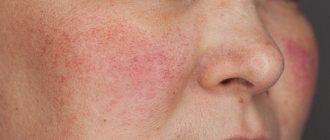General description of the procedure
Paraffin therapy is a heat treatment method. Physiotherapeutic direction of cosmetology, where with the help of melted paraffin and application in the form of applications, deep tissue heating occurs.
Paraffin consists of saturated acyclic hydrocarbons, the result of petrochemicals. The product is tasteless, odorless, insoluble in water, and when melted it is ideal for mixing with vegetable fats, such as cosmetic base oils.
The paraffin therapy procedure is suitable for treating the skin of the face and body, nails, joints, and muscles.
Thermodynamics and high heat capacity are distinctive beneficial properties. At a high melting point and heating to 52-55˚C, paraffin slowly releases heat, so there is absolutely no risk of skin burns.
There are two main types of paraffin produced - yellow and white.
Yellow is used in medical centers and sanatoriums to relieve pain in joints and muscles.
In cosmetology practice, a white product is used. It is more suitable for delicate facial skin than yellow. During production, white paraffin is thoroughly cleaned of impurities, which means that the risk of allergies is eliminated. If a skin reaction suddenly occurs, it is only because an excipient was added to the pure product (for example, essential or base cosmetic oil, honey, dyes) which can cause itching and redness. For allergy sufferers, only white, pure product is suitable.
Paraffin therapy can be cold or hot. In the first case, there is no need to melt the paraffin.
Diseases that can be cured at Naftalan resorts
The Naftalan resort is suitable for your indications if you have one or more of the following diagnoses:
Indications for the treatment of skin diseases:
One of the most effective methods for treating skin diseases is naftalan. It has anti-inflammatory, desensitizing, antihistamine and analgesic effects on the skin.
- psoriasis
- eczema
- atopic dermatitis
- sebary
- pityriasis rosea
- boils
- cycosis and other pyoderma
- hives
- scleroderma
- itching
- wounds
- bedsores
- torpid ulcers
- ichthyosis
- keratoderma and others
It is worth remembering that treatment worsens the symptoms of psoriasis. This is a normal reaction of the body to naphtha and should not be alarmed. Symptoms will disappear on their own without additional treatment.
Benefits of paraffin therapy
Among the advantages of the procedure are the following:
- Eliminates dry skin, hair, nails.
- Treats psoriasis, neurodermatitis.
- Removes swelling and cellulite.
- Fights pigmentation.
- Heals cracks and scars.
- Tightens the skin.
- Relieves joint pain, arthritis, arthrosis.
- Treats neuralgia, osteochondrosis.
- Helps in complex therapy of the musculoskeletal system.
Types of procedures
Anti-aging face masks
Paraffin rejuvenates the face. In combination with additional agents, it is used as anti-age therapy. Smoothes wrinkles, removes bags under the eyes, resolves infiltrates. The mask removes dead cells and tissue regeneration occurs. Due to solidification, compression occurs. Light, pleasant pressure models an oval shape and removes a double chin. After six procedures, the face will become fresh, smooth, and acquire a delicate shade.
Anti-acne masks
Paraffin normalizes the sebaceous glands. Under the influence of heat, the pores open. Contaminants come to the surface of the dermis, are absorbed into paraffin and are removed along with the mask. The face is peeled, scars are removed, and blackheads are eliminated. To increase the effectiveness of the procedure, add lavender essential oil or a few drops of tea tree oil and aloe juice to the product.
Body applications
The hot paraffin therapy method warms up, opens the pores, increasing sweating. Toxins are actively removed through sweat. A sauna effect is created, due to which the skin is noticeably moisturized and tightened. And if valuable oils and vitamins are added to the product, the skin is nourished and saturated with useful microelements. Paraffin therapy of the body is used as a relaxing, therapeutic, care procedure in Spa centers.
For hands
It is an independent salon procedure for hands and nails. Restores nails after all types of extensions. Strengthens the plate, moisturizes dry cuticle. Prevention of hangnails. Softens rough, dry skin on elbows and hands. Transforms hands after contact with household chemicals. Has a lifting effect. Used in complex Spa programs to relieve tension. After the first procedure, your hands will become smooth and your nails will be shiny.
For legs
Relieves joint pain after wearing tight high-heeled shoes. Removes swelling. Provides relaxation and relief from daily stress. Strengthens nail plates. Softens rough skin on the heels.
Against pain
The paraffin product relieves myological joint pain and muscle tension. It is used in therapeutic massage at the warming stage.
For athletes, it is an indispensable remedy for relieving back pain or when it is necessary to quickly warm up a muscle.
There will also be benefits after injuries, in complex prevention with massage and therapeutic exercises. As rehabilitation after any types of fractures, dislocations.
For recovery from chronic arthritis and arthrosis.
Treats scaly lichen, scar tissue degeneration.
Useful properties of paraffin
Paraffin is a heat-intensive, dense substance that reduces its volume as it cools. What are the benefits of this spa treatment for hands and feet:
- Cleanses. The warm substance softens the top layer of skin and opens the pores. After removing the paraffin film, the skin remains deeply cleansed; toxins remain in the paraffin composition.
- Accelerates regeneration. The procedure speeds up metabolism, keeps the skin young and elastic, and slows down the aging process. As it cools, paraffin contracts in volume, acting like a massage.
- Relieves fatigue, relaxes muscles and has a positive effect on the overall condition of the skin.
- Improves lymphatic drainage. The paraffin composition removes waste and toxins, eliminates excess fluid, and relieves swelling.
- Reduces nail fragility, moisturizes cuticles.
Melted paraffin not only has a restorative effect on the skin. As it cools, paraffin transfers heat to the joints. Therefore, the procedure is useful for people suffering from arthritis and arthrosis. The effect of moisturized and soft skin lasts for several days.
Contraindications
Paraffin therapy is not recommended in the following cases:
- Inflammatory process, inflammation of any etymology. Exposure to a hot product dilates blood vessels. Nutrients are delivered to the site of inflammation, which activate the growth of pathogens.
- Atherosclerosis. The cosmetologist cannot know in which vessel your plaques have formed. Exposure to heat and deep heating of tissues, vasodilation - all this can potentially cause a heart attack, stroke, or pulmonary embolism.
- Pregnancy. The hot procedure dilates the blood vessels, which can cause bleeding and the threat of early labor.
- Cuts. Violation of the integrity of the skin is also a contraindication to paraffin therapy.
- Hypertension, varicose veins, angina pectoris.
- Diabetes. Is it possible to do paraffin therapy for diabetes - the question remains open. On the one hand, hot paraffin therapy aggravates the course of diseases of diabetics: blood circulation and microcirculation are disrupted, cracks, ulcers, and fungal diseases of the skin and nails occur. But in some sources of medical literature there is an opposite opinion that for diabetic feet, a physiotherapeutic procedure - paraffin therapy - is indicated as it improves the skin of the feet and nails. Consult an endocrinologist before going to a beauty salon.
- For those who have allergies, dermatosis, skin infections, paraffin is not indicated.
Indications for the treatment of gynecological diseases:
Naftalan treats gynecological diseases, providing the body with anti-inflammatory, desensitizing, general and partial immunostimulating, analgesic and neurotrophic effects, and improves blood circulation in the pelvic organs. In addition, thanks to certain types of bacteria and mold fungi, the substance has bactericidal properties, promotes the healing of scars and softens seams.
- adenxitis, salpingophoritis
- parametritis
- endometritis
- servicitis, chronic recurrent colpitis
- amenorrhea
- dysfunction
- first and second degree infertility
- climacteric syndrome
- peritoneal joints of the pelvis
Adverse reactions
Side effects include:
- A side effect is a burn. Despite the fact that in the salon and medical centers it is impossible to get a burn, at home it is easy to get one. Never mix paraffin with water, put it in a wet container, or apply it yourself at home. Since water has greater thermal conductivity than thick paraffin mass.
- Hives. Blisters may occur locally at the area where the product is applied. In rare cases, breathing becomes impaired, blood pressure drops sharply, and anaphylactic shock occurs.
- Home use of paraffin leads to serious errors. For example, to suppuration, aggravation of the problem from which a person tried to get rid of with the help of home applications. Only a master knows how to do it correctly and without serious consequences.
- Compared to other methods, paraffin is safe. Affordable and very effective, cannot be self-prescribed. For adequate treatment, you need to consult a cosmetologist, cosmetologist-dermatologist, endocrinologist, allergist. The specialist will tell you how often you can do the procedure.
Diseases of the peripheral nerves and central nervous system
The neuroimmune system is constantly under stress, and overexertion affects our mental and physical health. The use of naphtha in the treatment of the diseases and symptoms listed below allows us to achieve a lasting positive therapeutic effect.
- Diseases of the peripheral nervous system
- Neuralgia and neuritis of various etiologies
- Radiculitis (including lumbosacral)
- Damage to the peripheral nervous system after trauma
Diseases of the central nervous system
- The initial stage of atherosclerosis in the arteries of the brain
- Consequences of traumatic injuries to the spinal cord and brain (concussion, contusion) in the absence of serious motor disorders
- Astheno-vegetative syndrome
Method of performing paraffin therapy
- The master thoroughly cleanses the skin, performs light peeling, and applies a light cream or cosmetic oil.
- Paraffin is placed in the thermostat and heated to the permissible temperature mark. There can be several methods for applying paraffin. They all depend on the type of procedure. Layering is suitable for hands, a bath is suitable for legs, feet, hands. Applications – for joints and face masks.
- Cover the area with a terry towel or thermal blanket. Put gloves or mittens on your hands, and socks on your feet.
- After 15-20 minutes, the product is removed. The exposure time depends on the area of the skin.
- The session ends with the application of a nourishing, protective cream.
Return to list of articles
